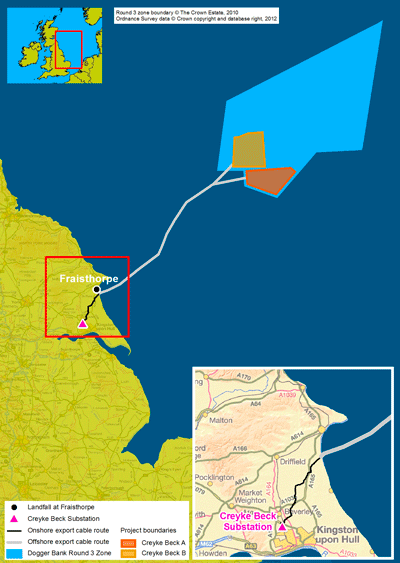400 wind turbines will be constructed in the North Sea off the Yorkshire coast as part of the world's largest offshore wind farm
An offshore wind farm with 400 turbines off the Yorkshire coast has been given the go-ahead. The windfarm, which will be made of two arrays of 200 turbines each and covers an area of over 500km2 (193 square miles) will dwarf the London Array, currently the country’s largest windfarm with 175 turbines in the Outer Thames Estuary.
The offshore wind farms will be constructed 131 kilometres (70 miles) from the UK coast and will connect into the existing Creyke Beck substation near Cottingham, in the East Riding of Yorkshire. The project will include:
- – Up to 400 wind turbines with fixed foundations
- – Two offshore high voltage direct current (HVDC) converter platforms with fixed foundations
- – Up to eight offshore collector platforms with fixed foundations
- – Up to four offshore accommodation or helicopter platforms with fixed foundations
- – Up to ten offshore meteorological monitoring stations with fixed foundations
- – Subsea cables between the elements of offshore infrastructure
- – Offshore export cables carrying electricity from the offshore HVDC converter platforms to the Holderness coast
The Dogger Bank Creyke Beck offshore wind farm will be developed by consortium Forewind, made up of international firms RWE, SSE, Statkraft and Statoil, which has been given a first consent order by The Crown Estate, manager of the UK seabed.
The application was approved by Energy and Climate Change Secretary Ed Davey approved the application for the largest renewable energy development ever to receive planning consent in the UK.
Dogger Bank Creyke Beck is part of the Dogger Bank Zone, the largest of the Round 3 zones of areas available for offshore development. It is ideally suited to offshore windfarming because of the shallow depths, high wind speed and suitable seabed conditions.
£60 million has already been spent on surveys of the site, and Siemens, the German firm that makes turbines, is investing £160m in factory in Yorkshire to build turbine blades. Associated British Ports which works with Siemens for offshore wind projects is also investing a £150m.
This is dwarfed by the cost of the project itself, which is likely to be as high as £8 billion, with the two windfarms that form the project costing £3-4 billion each.
The turbines themselves won’t be in place for at least another five years, according to Forewind.
Now that approval has been given, the operators who will be designing, engineering, constructing and erecting the turbines can begin their work, alongside the financial and infrastructure planning that has to be put in place.
Energy and Climate Change Secretary Ed Davey said:
‘This is another great boost for Yorkshire and Humberside. This development has the potential to support hundreds of green jobs and power up to 2 million homes.’
Dogger Bank Creyke Beck, will have a total generating capacity of 2.4GW, making it the second largest power station of any kind in the UK, behind the 3.9GW Drax coal-fired station in North Yorkshire.






